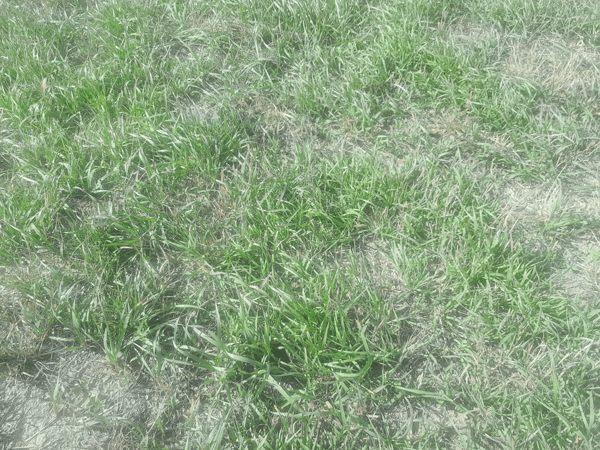Brome requires annual fertilization for optimum production. Fall is a good time to plan on fertilizing cool-season perennial grasses such as smooth brome (Figure 1). Particular attention must be paid to nitrogen, phosphorus, potassium, and pH.
Balanced fertility is essential. For example, adding nitrogen will not produce optimum yields if phosphorus is low. Soils low in phosphate limit plant and root growth. Fertilizer should be applied by broadcasting in the fall or before spring growth begins.


Figure 1. Fall growth of established smooth brome field prior to fertilizer application. Photos by John Holman, K-State Research and Extension.
Nitrogen Source. Nitrogen management is critical for optimum smooth brome production. Several nitrogen sources are available—liquid nitrogen solutions, urea, ammonium nitrate, and anhydrous ammonia. Anhydrous ammonia is not extensively used on permanent pastures because application is difficult. Nitrogen source research generally has shown little difference among sources under most conditions. When urea fertilizers—including liquid nitrogen—are applied to moist soils covered with grass residue, an enzyme called urease can break down the urea to ammonia, which is lost to the air. This can occur fairly rapidly when moist conditions are followed by warm temperatures and rapid drying occurs without rain to move the urea into the soil. If urea is applied from November through February, volatilization loss should be minimal.
Application Timing. When brome is grazed in the fall, the yearly nitrogen application should be split. If adequate soil moisture is available for good growth in late August and early September, apply all phosphorus and potassium indicated by a soil test plus 30-40 pounds of nitrogen per acre. Before the soil freezes in November or December, apply the remainder of the nitrogen recommended for haying or grazing. Split or late fall applications generally initiate earlier green-up in the spring.
If soil moisture is limited, apply all nitrogen, phosphorus, and potassium before the soil freezes in November or December. Do not apply fertilizer to frozen soil to minimize loss.
Spring applications as soon as the soil thaws are acceptable for spring-only grazing. Timely application is often delayed because of wet soils. An application needs to be applied in the fall or early spring to allow sufficient time for fertilizer incorporation to benefit forage production (Figure 2).

Figure 2. Timing of N application on smooth brome yield. Source: KSRE publication C402 Smooth Brome Production and Utilization.
Fertilizer Rates (N, P, and K). Fertilizer rate recommendations for N, P, and K for established stands of smooth bromegrass are shown in Tables 1, 2, and 3, respectively. When brome is to be utilized for hay production, excessive nitrogen may cause lodging and reduce the amount of harvestable hay. In Table 1, the lower values in the rate range are for hay production. Nitrogen rate should be selected based on factors such as fertilizer cost, hay price, and/or grazing pressure.
Table 1. Nitrogen recommendations for smooth bromegrass.
|
Type |
Area of State |
lb/a N1 |
|
New Seeding |
Entire |
30-40 |
|
Established Stands: |
||
|
Non-irrigated |
Eastern |
80-120 |
|
Non-irrigated |
Central |
40-80 |
|
Irrigated |
Entire |
125-200 |
1In established stands, the lower recommendations are for hay
management only. The higher rates are for grazing or grazing and hay management.
Table 2. Phosphorus recommendations for smooth bromegrass.
|
|
Soil Test Level (ppm P) |
||||
|
Very Low |
Low |
Medium |
High |
Very High |
|
|
Type |
(0-5) |
(6-12) |
(13-25) |
(26-50) |
(51 or more) |
|
lb/a P2O5 |
|||||
|
New Seeding |
60-80 |
40-60 |
20-40 |
None |
None |
|
Established Stands: |
|||||
|
Non-irrigated |
30-50 |
20-40 |
0-30 |
None |
None |
|
Irrigated |
50-60 |
40-50 |
20-40 |
10-20 |
None |
Table 3. Potassium recommendations for smooth bromegrass.
|
|
Soil Test Level (ppm K) |
||||
|
Very Low |
Low |
Medium |
High |
Very High |
|
|
Type |
(0-40) |
(41-80) |
(81-120) |
(121-160) |
(161 or more) |
|
lb/a K2O |
|||||
|
New Seeding |
80-100 |
60-80 |
30-60 |
0-30 |
None |
|
Established Stands: |
|||||
|
Non-irrigated |
30-50 |
20-40 |
0-30 |
None |
None |
|
Irrigated |
50-60 |
40-50 |
20-40 |
0-20 |
None |
John Holman, Cropping Systems Agronomist – Garden City
jholman@ksu.edu
Dorivar Ruiz Diaz, Soil Fertility Specialist
ruizdiaz@ksu.edu
Tags: pastures fall fertilizer bromegrass fertilization smooth brome